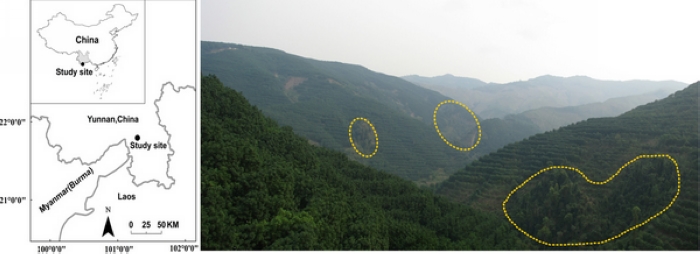生境丧失是生物多样性保护面临的最大困难,尤其是生物多样性丰富的热带地区。热带亚洲因为现存原始生境较少,却仍面临较高的森林退化率而备受关注。种植园(橡胶园,棕榈园等)替代低海拔森林是如今热带亚洲森林持续较少的主要因素之一。种植园在发展过程中产生了大量的被分割和包围的原始森林斑块,这些斑块大多分布在地势陡峭的沟边,因为难以开发而得以保存。同时这些斑块还受周边人类活动影响,其森林结构也发生了较大的改变。作为伴随人类生产活动而出现的生境类型,分布很广,但其对生物多样性的保护价值仍不清楚。
版纳植物园动物行为与环境变化研究组的研究人员在西双版纳选择了15个被橡胶林完全分割的森林斑块进行鸟类多样性调查,结果表明:1)斑块中鸟类组成不稳定,受季节影响大,斑块面积和形状是影响鸟类多样性的主要因素;2)被橡胶林分割的单一森林斑块难以维持该区丰富的鸟类资源,但相邻的众多斑块具有互补性,整合在一起可以存活较多的鸟类物种;3)一些体型较大的鸟类,食果鸟类,以及地面食虫鸟类群等对森林片段化更为敏感。最后,基于该研究结果讨论并建议如何改善橡胶种植区生物多样性保护现状。
该研究成果以

研究地点和森林斑块示意
Bird conservation in extremely small tropical rainforest patches in southwest China
Tropical forests support high levels of avian diversity but these areas have been impacted by extensive deforestation. The lowland tropical rainforest of Xishuangbanna in southwest China is one such impacted hotspot. In this region, rubber (Hevea brasiliensis) plantations have replaced most of the original forest,
but numerous small fragments of forest remain. To assess the value of these fragments to avian diversity, we classified the fifteen selected remnant forest patches into three size categories, <1 ha, 1–3 ha, and 3–6 ha, and conducted avifauna surveys. We found that 97 bird species inhabit the fragments and that bird diversity increases with patch area. The resident species composition similarity index was low among forest patches, both within and across size categories, and also low between the wet and dry seasons. Ground insectivores, frugivores and large bird species were the most vulnerable to habitat fragmentation. Our study encouragingly shows that fragments can play an important role in bird conservation in regions that now lack large tracts of natural forest; however, current patches are too small to support stable annual populations of some species, while others are more tolerant of fragmentation. We discuss these findings and provide conservation strategies to improve bird conservation within rubber plantations in southern China.